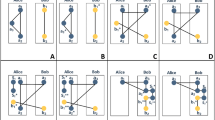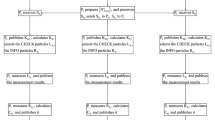Abstract
Based on locally indistinguishable orthogonal product states, we propose a novel multiparty quantum key agreement (QKA) protocol. In this protocol, the private key information of each party is encoded as some orthogonal product states that cannot be perfectly distinguished by local operations and classical communications. To ensure the security of the protocol with small amount of decoy particles, the different particles of each product state are transmitted separately. This protocol not only can make each participant fairly negotiate a shared key, but also can avoid information leakage in the maximum extent. We give a detailed security proof of this protocol. From comparison result with the existing QKA protocols, we can know that the new protocol is more efficient.



Similar content being viewed by others
Explore related subjects
Discover the latest articles, news and stories from top researchers in related subjects.References
Diffie, W., Hellman, M.: New direction in cryptography. IEEE Trans. Inf. Theory 22, 644–654 (1976)
Ingemarsson, I., Tang, D.T., Wong, C.K.: A conference key distribution system. IEEE Trans. Inf. Theory 28, 714–719 (1982)
Steiner, M., Tsudik, G., Waidner, M.: Key agreement in dynamic peer groups. IEEE Trans. Parallel Distrib. Syst. 11, 769–780 (2000)
Mitchell, C.J., Ward, M., Wilson, P.: Key control in key agreement protocols. Electron. Lett. 34(10), 980–981 (1998)
Ateniese, G., Steiner, M., Tsudik, G.: New multiparty authentication services and key agreement protocols. IEEE J. Sel. Areas Commun. 18(4), 628–639 (2000)
Wang, T.Y., Wen, Q.Y., Chen, X.B.: Cryptanalysis and improvement of a multi-user quantum key distribution protocol. Opt. Commun. 283(24), 5261–5263 (2010)
Salas, P.J.: Security of plug-and-play QKD arrangements with finite resources. Quantum Inf. Comput. 13, 861–879 (2013)
Deng, F.G., Long, G.L., Liu, X.S.: Two-step quantum direct communication protocol using the Einstein–Podolsky–Rosen pairblock. Phys. Rev. A 68, 042317 (2003)
Cui, Y.J.: Uniqueness of solution for boundary value problems for fractional differential equations. Appl. Math. Lett. 51, 48–54 (2016)
Qin, S.J., Gao, F., Wen, Q.Y., et al.: Improving the security of multiparty quantum secret sharing against an attack with a fake signal. Phys. Lett. A 357, 101–103 (2006)
Gao, F., Guo, F.Z., Wen, Q.Y., et al.: Quantum key distribution without alternative measurements and rotations. Phys. Lett. A 349, 53–58 (2006)
Long, G.L., Liu, X.S.: Theoretically efficent high capacity quantum key distribution scheme. Phys. Rev. A 65, 032302 (2002)
Boström, K., Felbinger, T.: Deterministic secure direct communication using entanglement. Phys. Rev. Lett. 89, 187902 (2002)
Deng, F.G., Long, G.L.: Secure direct communication with a quantum one-time pad. Phys. Rev. A 69, 052319 (2004)
Gao, F., Qin, S.J., Wen, Q.Y., Zhu, F.C.: Cryptanalysis of multiparty controlled quantum secure direct communication using Greenberger–Horn–Zeilinger state. Opt. Commun. 283, 192–195 (2010)
Huang, W., Zuo, H.J., Li, Y.B.: Cryptanalysis and improvement of a multi-user quantum communication network using type entangled states. Int. J. Theor. Phys. 52, 1354–1361 (2013)
Lin, S., Wen, Q.Y., Zhu, F.C.: Quantum secure direct communication with \(\chi \)-type entangled ststes. Phy. Rev. A 78, 064304 (2008)
Tseng, H.Y., Lin, J., Hwang, T.: New quantum private comparison protocol using EPR pairs. Quantum Inf. Process. 11, 373–384 (2011)
Liu, W., Wang, Y.B., Jiang, Z.T.: An efficient protocol for the quantum private comparison of equality with W state. Opt. Commun. 284, 3160–3163 (2011)
Martini, F.D., Giovannetti, V., Lloyd, S., Maccone, L., et al.: Experimental quantum private queries with linear optics. Phys. Rev. A 80, 010302 (2009)
Jakobi, M., Simon, C., Gisin, N., Bancal, J.D., et al.: Practical private database queries based on a quantum-key-distribution protocol. Phys. Rev. A 83, 022301 (2011)
Gao, F., Liu, B., Huang, W., Wen, Q.Y.: Postprocessing of the oblivious key in quantum private query. IEEE. J. Sel. Top. Quantum 21, 6600111 (2015)
Wei, C.Y., Wang, T.Y., Gao, F.: Practical quantum private query with better performance in resisting joint-measurement attack. Phys. Rev. A 93, 042318 (2016)
Wei, C.Y., Cai, X.Q., Liu, B., et al.: A generic construction of quantum-oblivious-key-transfer-based private query with ideal database security and zero failure. IEEE Trans. Comput. 67(1), 2–8 (2018)
Zeng, G.H., Keitel, C.H.: An arbitrated quantum signature algorithm. Phys. Rev. A 65, 042312 (2002)
Lee, H., Hong, C.H., Kim, H., et al.: Arbitrated quantum signature scheme with message recovery. Phys. Rev. A 321, 295–300 (2004)
Wen, X.J., Niu, X.M., Ji, L.P.: A weak blind signature scheme based on quantum cryptography. Opt. Commun. 282, 666–669 (2009)
Wang, T.Y., Wen, Q.Y.: Fair quantum blind sigantures. Chin. Phys. B 19, 060307–060311 (2010)
Wen, X.J., Tian, Y., Niu, X.M.: A group signature scheme based on quantum teleportation. Phys. Scr. 81, 055001–055006 (2010)
Liu, F., Qin, S.J., Su, Q.: An arbitrated quantum signature scheme with fast signing and verifying. Quantum Inf. Process. 13, 491–502 (2014)
Xu, G.B., Zhang, K.J.: A novel quantum group signature scheme without using entangled states. Quantum Inf. Process. 14, 2577–2587 (2015)
Xu, G.B.: Novel quantum proxy signature without entanglement. Int. J. Theor. Phys. 54(8), 2605–2612 (2015)
Zhou, N., Zeng, G., Xiong, J.: Quantum key agreement protocol. Electron. Lett. 40, 1149–1150 (2004)
Tsai, C., Hwang, T.: On quantum key agreement protocol. Technical report, C-S-I-E, NCKU, Taiwan, ROC (2009)
Chong, S.K., Tsai, C.W., Hwang, T.: Improvement on quantum key agreement protocol with maximally entangled states. Int. J. Theor. Phys. 50(6), 1793–1802 (2011)
Shi, R.H., Zhong, H.: Multi-party quantum key agreement with bell states and bell measurements. Quantum Inf. Process. 12, 921–932 (2013)
Liu, B., Gao, F., Huang, W., Wen, Q.Y.: Multiparty quantum key agreement with single particles. Quantum Inf. Process. 12, 1797–1805 (2013)
Huang, W., Wen, Q.Y., Liu, B., Fei, G., Sun, Y.: Quantum key agreement with EPR pairs and single-particle measurements. Quantum Inf. Process. 13(3), 649–663 (2014)
Liu, B., Xiao, D., Jia, H.Y., Liu, R.Z.: Collusive attacks to circle-type multi-party quantum key agreement protocols. Quantum Inf. Process. 15, 2113 (2016)
Sun, Z.W., Zhang, C., Wang, B.H., et al.: Improvements on multiparty quantum key agreement with single particles. Quantum Inf. Process. 12(11), 3411–3420 (2013)
Shukla, C., Alam, N., Pathak, A.: Protocols of quantum key agreement solely using Bell states and Bell measurement. Quantum Inf. Process. 13(11), 2391–2405 (2014)
Zhu, Z.C., Hu, A.Q., Fu, A.M.: Improving the security of protocols of quantum key agreement solely using Bell states and Bell measurement. Quantum Inf. Process. 14(11), 4245–4254 (2015)
Sun, Z.W., Yu, J.P., Wang, P.: Efficient multi-party quantum key agreement by cluster states. Quantum Inf. Process. 15, 373–384 (2016)
Sun, Z.W., Zhang, C., Wang, P., Yu, J.P., Zhang, Y., Long, D.Y.: Multi-Party quantum key agreement by an entangled six-qubit state. Int. J. Theor. Phys. 55(3), 1920–1929 (2016)
Xu, G.B., Wen, Q.Y., Gao, F., Qin, S.J.: Novel multiparty quantum key agreement protocol with GHZ states. Quantum Inf. Process. 13(12), 2587–2594 (2014)
Yin, X.R., Wen, W.P., Shen, D.S., et al.: Three-party quantum key agreement with Bell states. Acta Phys. Sin. 62(17), 170304 (2013)
He, Y.F., Ma, W.P.: Quantum key agreement protocols with four-qubit cluster states. Quantum Inf. Process. 14(9), 3483–3498 (2015)
Yang, Y.H., Gao, F., Xu, G.B., Zuo, H.J., Zhang, Z.C., Wen, Q.Y.: Characterizing unextendible product bases in qutrit-ququad system. Sci. Rep. 5, 11963 (2015)
Ma, H.J., Jia, Y.M.: Stability analysis for stochastic differential equations with infinite Markovian switchings. J. Math. Anal. Appl. 435, 593–605 (2016)
Wang, Z., Huang, X., Shi, G.D.: Analysis of nonlinear dynamics and chaos in a fractional order financial system with time delay. Comput. Math. Appl. 62, 1531–1539 (2011)
Yu, S.X., Oh, C.H.: Detecting the local indistinguishability of maximally entangled states (2015). arXiv:1502.01274v1 [quant-ph]
Wang, Y.L., Li, M.S., Zheng, Z.J., Fei, S.M.: Nonlocality of orthogonal product-basis quantum states. Phys. Rev. A 92, 032313 (2015)
Zhang, Z.C., Gao, F., Cao, Y., Qin, S.J., Wen, Q.Y.: Local indistinguishability of orthogonal product states. Phys. Rev. A 93, 012314 (2016)
Xu, G.B., Wen, Q.Y., Qin, S.J., Yang, Y.H., Gao, F.: Quantum nonlocality of multipartite orthogonal product states. Phys. Rev. A 93(3), 032341 (2016)
Xu, G.B., Yang, Y.H., Wen, Q.Y., Qin, S.J., Gao, F.: Locally indistinguishable orthogonal product bases in arbitrary bipartite quantum system. Sci. Rep. 6, 31048 (2016)
Xu, G.B., Wen, Q.Y., Gao, F., Qin, S.J., Zuo, H.J.: Local indistinguishability of multipartite orthogonal product bases. Quantum Inf. Process. 16, 276 (2017)
Guo, G.P., Li, C.F., et al.: Quantum key distribution scheme with orthogonal product states. Phys. Rev. A 64, 042301 (2001)
Zhao, Q.Y., Zhang, D.X., Li, X.Y.: Quantum key distribution protocol using orthogonal product quantum states. J. Univ. Electr. Sci. Technol. China 37(3), 401–403 (2008)
Yang, Y.G., Wen, Q.Y., Zhu, F.C.: An efficient quantum secret sharing protocol with orthogonal product states. Sci. China Phys. Mech. 50, 331–338 (2007)
Walgate, J., Hardy, L.: Nonlocality, asymmetry, and distinguishing bipartite states. Phys. Rev. Lett. 89, 147901 (2002)
Deng, F.G., Li, X.H., Zhou, H.Y., Zhang, Z.J.: Improving the security of multiparty quantum secret sharing against Trojan horse attack. Phys. Rev. A 72, 044302 (2005)
Li, X.H., Deng, F.G., Zhou, H.Y.: Improving the security of secure direct communication based on the secret transmitting order of particles. Phys. Rev. A 74, 054302 (2006)
Cai, Q.Y.: Eavesdropping on the two-way quantum communication protocols with invisible photons. Phys. Lett. A 351, 23–25 (2006)
Cabello, A.: Quantum key distribution in the Holevo limit. Phys. Rev. Lett. 85, 5635–5638 (2000)
Acknowledgements
This work is supported by NSFC (Grant Nos. 61402148, 61601171) and Project of Science and Technology Department of Henan Province of China (172102210275).
Author information
Authors and Affiliations
Corresponding author
Appendix: a proof of Theorem 1
Appendix: a proof of Theorem 1
Proof
Now we prove the states (1) cannot be perfectly distinguished by LOCC if the first party goes first. If so, then by their symmetry these states cannot be perfectly distinguished with the second party going first.
Suppose that the first party performs a general measurement with a set of \(3\times 3\) POVM elements \(\{M^{\dag }_{k}M_{k};\,k=1,2,\ldots ,l_{1}\}\), where
under the basis \(\{|0\rangle ,|1\rangle ,|2\rangle \}\).
It is noted that the postmeasurement states must be pairwise orthogonal for making further discrimination feasible. That is, the states that are orthogonal on the first side should maintain the orthogonality on the first side after the measurement.
For the states \(|\psi _{1}\rangle \) and \(|\psi _{5}\rangle \), we can get
i.e.,
Thus,
For the states \(|\psi _{2}\rangle \) and \(|\psi _{5}\rangle \), we can get
i.e.,
Thus,
So, we have
For the states \(|\psi _{3}\rangle \) and \(|\psi _{7}\rangle \), we can get
i.e.,
Thus,
For the states \(|\psi _{4}\rangle \) and \(|\psi _{7}\rangle \), we can get
i.e.,
Thus,
So, we have
For the states \(|\psi _{1}\rangle \) and \(|\psi _{2}\rangle \), we can get
i.e.,
Thus,
So, we have
For the states \(|\psi _{3}\rangle \) and \(|\psi _{4}\rangle \), we can get
i.e.,
Thus,
So, we have
This means that any of the POVM elements of the first party should be in the form
Consider the states \(|\psi _{5}\rangle \) and \(|\psi _{7}\rangle \). If the first party distinguishes the states outright then for one of states \(|\psi _{5}\rangle \) and \(|\psi _{7}\rangle \), \(\langle \psi _{i}|M_{k}^{\dag }M_{k}\otimes (I_{3\times 3})^{\otimes 4}|\psi _{i}\rangle =0.\) But given (25), \(\langle \psi _{i}|M_{k}^{\dag }M_{k}\otimes (I_{3\times 3})^{\otimes 4}|\psi _{i}\rangle =m_{00}^{k}.\) Thus, \(m_{00}^{k}=0\) and, since POVM elements must be positive, \(M_{k}^{\dag }M_{k}\) is the null matrix.
According to the above analysis, all of the first party’s POVM elements must be proportional to the identity. Thus, the first party cannot go first and by the symmetry of states (1), neither can the second party. Therefore, these states are locally indistinguishable. This completes the proof. \(\square \)
Rights and permissions
About this article
Cite this article
Jiang, DH., Xu, GB. Multiparty quantum key agreement protocol based on locally indistinguishable orthogonal product states. Quantum Inf Process 17, 180 (2018). https://doi.org/10.1007/s11128-018-1951-5
Received:
Accepted:
Published:
DOI: https://doi.org/10.1007/s11128-018-1951-5




